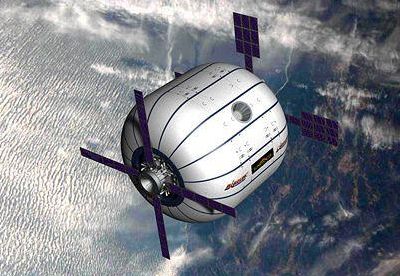One last mission?by Taylor Dinerman
|
| What would be the goal of such a mission? Delivering spare parts would somehow seem a bit mundane for such a momentous occasion. |
There is a space solar array in storage that might be a useful long-term addition to the station. It would, however, take more than one shuttle flight to attach it to the truss, even if all the hardware were space-qualified and ready to go. It would be possible to refit another of the Multi Purpose Logistics Modules as a lab, living quarters, or as more pressurized storage space, but that would be only a little more exciting than delivering another batch of spares.
The one item that is now in production that would truly be exciting and would show NASA’s commitment to true “game changing” technology is the large inflatable Sundancer modules being built by Bigelow Aerospace. Based on technology that NASA decided not to use for the large TransHab module, putting one of these on the station using the last shuttle flight would dramatically increase living space available on the ISS and make it a more attractive place to work or visit.
The modules are being built at Bigelow’s Las Vegas facility and one could be sold to NASA for refitting either at the Cape or in Houston. There are several old designs for the interior, notably by Italian architect Paola Favata, that could be brushed off and used. With a Sundancer attached, the ISS could, in the long term, be a larger space hotel than anything Bigelow now has planned.
It might even be possible to imagine a time that the ISS could host a much larger human contingent that the current six-person crew. With three four-seat or two six-seat Orion “lifeboats” attached and an enhanced life support system, there might be room for as many as a dozen people.
| The one item that is now in production that would truly be exciting and would show NASA’s commitment to true “game changing” technology is the large inflatable Sundancer modules being built by Bigelow Aerospace. |
Over the years NASA and Bigelow could study the behavior of the materials used on the Sundancer and directly compare them with the materials used in the more conventional structures on the station. This might give NASA some, but not all, of the data on radiation shielding that it desperately needs in order to plan for human missions beyond LEO. Ten years ago the agency claimed that the thick composite walls of the TransHab were far better protection against the invisible hazards of life in space than traditional aluminum. This could be a chance to find out if those claims were justified.
If NASA and Congress decide not to fly another shuttle mission there has been some talk of using the hardware to build a prototype for a new shuttle-derived vehicle with an in-line configuration, that is, with the payload mounted on top instead of on the side where the orbiter usually is.
This system is tentatively called the Ares 3. With enough time and money this would certainly be possible. The effort needed to design a system to attach and operate the rocket engines that would have to be fitted to the bottom of the main tank would be considerable. If this were to be a one-off experiment it would hardly seem worth the trouble. If, on the other hand, this concept is designed mostly to insure that the Ares program would remain alive as an option for future administrations and Congresses then, in that context, it makes political sense.
Right now all of NASA’s plans are in flux. While the president has laid out his proposals they are far from being accepted. It is hard to see any clear direction being given to the US space agency by its political masters until at least the final budget is passed sometime in the fall, if then. Senator Barbara Milkulski asked recently if it made any sense to keep changing the program every four years; that remains a good question.
